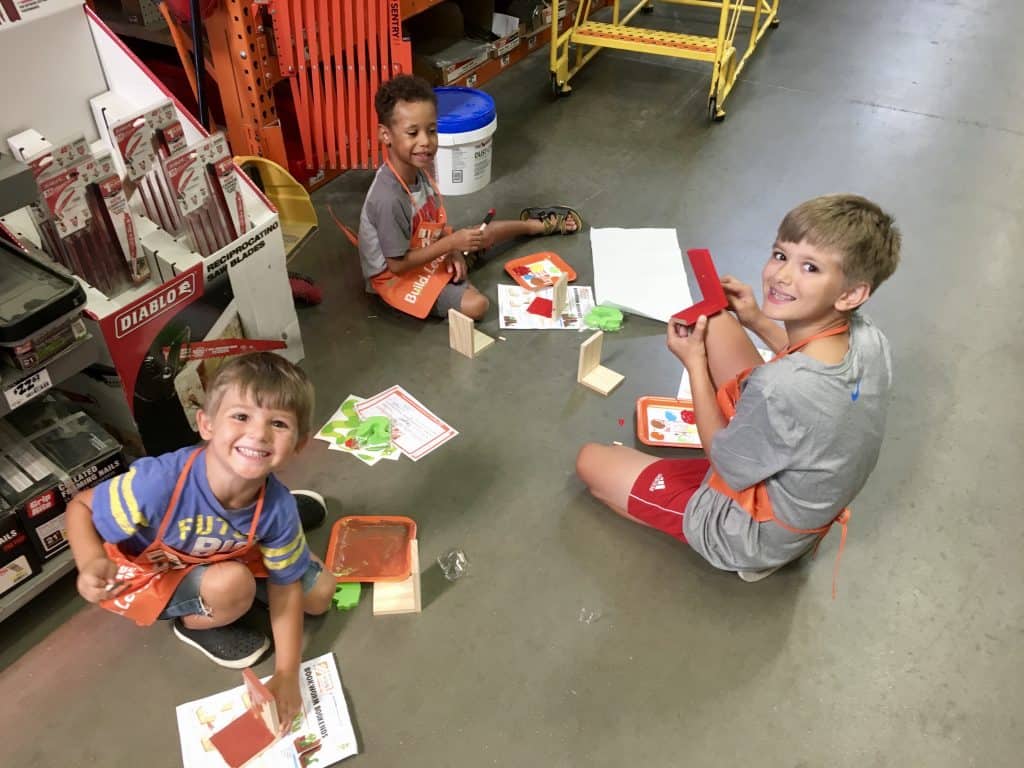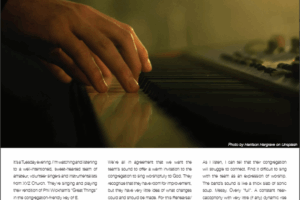Take this link to read the full article about Grant's More Than Music Workshops, as…

SOUNDCHECK & REHEARSALS – “PAINTING, PARTS AND PREPARATION”
By Grant Norsworthy
I have three sons. Max is my oldest. He’s eleven. Then there’s five-year-old Marcus and four-year-old Casper. Some Saturday mornings, we go to our local home improvement store to build simple wooden kit models together. Once they’re built, the boys get to paint them. It’s a lot of fun – and Mom gets a break!
Watching each boy paint their models is a wonderful, visual demonstration of what is needed from soundcheck and rehearsal for Church bands.
As you’d expect, my sons’ ability to complete this task – and the quality of the end results – is directly proportional to the age of each boy. Max flies completely solo with excellent results. Marcus is coming along, but still needs quite a bit of help.
Casper is really just “helping” me with his build. I explain the diagrammed instructions, position pieces of wood and hold each nail for Casper to hit with his little hammer (bracing for the pain) until he runs out of steam. I generally hammer them home for him. But I do let him paint exactly the way he wants to. It’s how it was with his older brothers at the same age.
Each boy is given the same materials for the painting of their model – a plastic plate with five blobs of different colored paint, a foam brush and a cup of water. But the end results are massively different.
11yo MAX
Max keeps the colors on his plate separated. Sometimes he’ll deliberately and carefully mix two colors together on a clean part of the plate to make a new shade. He plans how he will paint his model before starting. He applies paint with restraint and intentionality. No blobs! He washes his brush between each color’s application. No inadvertent blurring of color! He works to present a coherent, defined, clean paint scheme. It looks great.
This is like the Church band where all team members – singers, instrumentalists and technicians alike – have the same, clear goal: To get the congregation singing!
They soundcheck properly before every rehearsal. Isolating each sound source – every microphone and DI – assessing its quality, level and EQ to the satisfaction of the audio engineer (FOH) and those on the platform (monitors). Each sound being checked is delivered in the same form as for rehearsal and the service. Everyone on the platform sets a monitor mix that ensures that they are aware of the sonic contribution of every other element to the overall sound.
All singers and instrumentalist come to the rehearsal with a thorough knowledge of the songs – having planned their parts ahead of time during their personal practice – and know how they should fit with all the other sonic elements that exist within the song.
As the songs are rehearsed, the audio engineer works from a “palette” of defined musical elements – each dwelling in their own sonic “space”, or perhaps are intentionally blended with one or more other elements. Now, the audio engineer can apply these “colors” to the room’s “canvas”. Painting each song’s “picture” to achieve the desired goal of inviting the congregation to sing the songs worshipfully to God.
5yo MARCUS
Marcus has a good idea of how he wants his model to look. He watches Max, sees what his older brother is doing and is stretching himself to achieve similar results. But Marcus tends to jump into the painting with very little forethought. His hand control is not as good as Max’s yet and he often applies too much paint, making messy blobs. He sometimes forgets to wash his brush and the colors get unintentionally and unevenly mixed together on the plate and on the model. He generally has fun, but he knows it could be better and he’s working on it. He can sometimes be disappointed – even frustrated – with the results.
Some church bands are just like Marcus. There is some understanding of the team’s goal: “We want to craft a sound in our room that warmly invites our church congregation to find their voice to sing prayers, praises and God’s truth”. But how to get there is not yet fully grasped by everyone and it’s not well communicated by leadership. Some members want to improve, read articles (like this one) or watch training videos as like these and they have a sense of how much more effective the team could be. There’s some progress, but there’s also frustration.
They might soundcheck, but it’s a bit confused and far from complete. While some of those on the platform are trying to monitor every element of the ensemble’s sound, some are way too focused on their own sound, and may be totally unaware of what other people are singing and playing. Some others have never been taught, and therefore do not know what they should be hearing on the platform, so they do their best while treading water in a “sonic soup” of confusion.
Most instrumentalists seem to be playing constantly with very little dynamic, musical or tonal variation. There’s a lot of overplaying and over-singing. Vocalists are interpreting the melody differently from one another, with incongruent vocal styles. The drummer plays too hard and is too busy. He’s using a metronome click but often tugs ahead of it. The bassist and drummer are not listening to, nor playing with each other. There’s no groove. There’s a lot of overlap – competition for attention – within the sonic landscape. The potential is there, but it’s a bit chaotic – confused.
The audio engineer is doing the best she can with what she’s given. But there’s only so much that’s possible when the “palette” of “colors” is so muddled.
4yo CASPER
Casper’s having a good time. He enjoys painting his model, but he’s really only doing it because he’s been given the opportunity. He’s not really aiming for any particular end result other than playing with paint. The model becomes more colorful, sure, but it’s a vomitous collage of green-brown with areas that hint towards primary colors. There are large patches of bare wood, and others with thick, slow-drying blobs of paint. There’s almost as much paint on Casper as there is on the model!
Some of the teams who have accepted the responsibility of providing music for their church gatherings are a bit like Casper. There’s no unified, understood goal. There is no agreed reason why. Primarily, they play, sing and tech because they are willing to do so. They might have some fun. Get to play their instruments. Sing some songs they (hopefully) like. Near enough is good enough. Most of them – or all of them – are volunteers after all! Nothing more is expected of them.
There’s little if any proper, personal preparation of songs. “Rehearsals” start late, sometimes without everyone present, and always include a lot of wasted time. There’s no real soundcheck. Essential fundamentals like tuning, time-keeping, tone, dynamics or even the details of how the song goes often remain ignored.
The results are shambolic. And a great deal of the mess can go totally unrecognized by the team members. The audio engineer is faced with an impossible task. The “color palette” is not suitable for the type of “painting” we’re trying to create. The congregation struggle to identify how, or if, they should respond – let alone sing along.
CONCLUSION
You might think I like Max’s painted, wooden model – and the band type it represents – the most. But you’d be wrong. While I recognize that it shows more maturity – and is more aesthetically pleasing than his brothers’ – I love my three sons equally. I think all three painted models are wonderful! Their mother and I can generally tell when our sons are doing their best for the stage of development they’re at. We will genuinely affirm and compliment each son’s efforts but encourage and instruct them all to recognize and internalize goals and improve over time.
I love the Max-like bands, the Marcus-like bands and the Casper-like bands. And I love working with each of them as More Than Music Mentor to help them come to grips with the BIG reasons why we sing and how to better achieve our goals. Every team has the potential to do better. To taste the higher joy that is possible through music.
It would trouble me deeply if my sons were not improving. I feel the burden of Church singers, instrumentalists and technicians “spinning their wheels in the mud” without clear direction, coaching and mentorship. Accepting mediocrity, or worse.
When the heart and the art of worshipping musicians is less that it could be, the whole church suffers. Even passionate worshippers will struggle to connect.
Max-like bands effectively embrace the congregation and guide them to sing passionate praises. I long to hear your church congregation singing better. After all, it’s what God’s written Word instructs us to do!
Let the word of Christ dwell in you richly,
teaching and admonishing one another in all wisdom,
singing psalms and hymns and spiritual songs,
with thankfulness in your hearts to God.
Colossians 3:16 (ESV)
This is an awesome privilege and responsibility. We can do better. We must!
And if you want help, contact me.
This article was first published by Worship Tech Director of the WFX Network on Oct 31, 2018.


